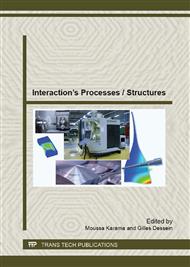p.11
p.21
p.29
p.39
p.49
p.59
p.69
p.79
p.89
Influence of the Addition of Mg, Maturation and Casting Techniques on the Evolution of Elastic, Plastic and Structural Properties of 44100 Polycrystalline Alloy
Abstract:
The addition of a high percentage of silicon and a small percentage of magnesium to aluminum are the main enhancers largely used to improve the mechanical characteristics. Our goal, here, is to make a direct contribution to the mechanical properties in traction, the hardness, the resilience and the structural properties of the AlSi13 alloy used in sand molding and shell metal molding, mechanical as well as manual. The reference state is designated by crude casting, noted: F. To increase the characteristics and obtain substantially large yield stresses and higher stiffnesses, the material of numerical designation 44100 is subjected to the specific heat treatments, quenching and annealing. This study aims to determine the influence of the chemical composition, the structural hardening of sand casting and metal shell casting by gravity on the evolution of the tensile behavior, hardness, resilience and microstructure of the binary alloy 44100.
Info:
Periodical:
Pages:
49-58
Citation:
Online since:
May 2013
Authors:
Price:
Сopyright:
© 2013 Trans Tech Publications Ltd. All Rights Reserved
Share:
Citation:


